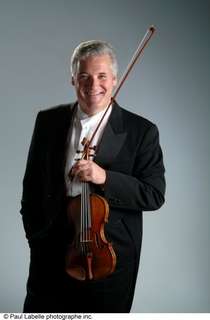|
Back
A. Berg On The Wing New York
Avery Fisher Hall, Lincoln Center
03/18/2010 - & March 19, 20, 2010
Matthias Pintscher: towards Osiris: Study for Orchestra (American Premiere)
Alban Berg: Violin Concerto
Johannes Brahms: Piano Quartet No. 1, opus 25 (Orchestrated by Arnold Schoenberg)
Pinchas Zukerman (Violin)
New York Philharmonic Orchestra, Christoph Eschenbach (Conductor)

P. Zukerman (© Paul Labelle)
This is a weekend of transformations for the fastidious Christopher Eschenbach and the New York Philharmonic. Arnold Schoenberg had transformed the Brahms Piano Quartet into a massive orchestral tapestry. Alban Berg had not only transformed a Bach chorale into his Violin Concerto, but he had transformed Schoenberg’s austere 12-tone doctrine into a thing of wistfulness, poetry and the deepest personal longings.
The American premiere of Matthias Pintscher’s towards Osiris was a kind of pre-transformation. This eight-minute work, which opened the program was a study which later would be used for Osiris, which was conducted here last year by Pierre Boulez.
I must confess that Osiris was by far the more satisfactory work. Within its 23 minutes, Mr Pintscher had time to show off the most dazzling orchestral effects, from wah-wah trumpets to electron-sized clusters of sound to the most shimmering violin-playing in the highest ranges. The legend of Osiris demands large forces and a far larger time element, for it contains savagery, reincarnation, death, devotion, and magic. Its elements were generated from ancient Babylonian to the Christ legend itself, and any composer with the chuzpah to attempt it has to be damned good.
Mr. Pintscher is not only daring in all his subjects, but he has the genius to paint the orchestra any way he wishes. (One is tempted to call him Matthias der Maler–Matthias the artist. But that title is taken already.) In towards Osiris, he again whirls the orchestra through dynamic paces. His solos for horns and solo trumpet are thrilling. His end with the upper strings strangely quiet, is stunning. But this musical miracle was not lasting: it was fireworks pure and simple. The later transformation into Osiris is still his masterpiece.
Pinchas Zukerman came to Alban Berg fairly late, introduced, he says, by Pierre Boulez in the 1970’s. But the Violin Concerto, without any doubt the most heartfelt and original of the 20th Century, is caviar for any great violinist.
Mr. Zukerman has recently been disappointing in “comfortable” concertos, but for the challenging ones, like Oliver Knussen and Alban Berg, nobody is superior.
I have the feeling he said to himself, “Berg wrung every possible emotion he could with his notes. I don’t have to go any further.” The result was startling. Mr. Zukerman played it with an almost audacious drama and spirit. He could understate, when necessary, in the Bach chorale, and in the second movement, he brought a kind of skittish delicacy when necessary. Berg dedicated it to “the memory of an angel”, and when one sees a picture of the girl who died too young, one knows that this angel was a tough confident girl. Mr. Zukerman was not interested in Raphael cherubic angels. His violin playing was dedicated to the lively spirit in us all. It was a stirring, full performance, never surrendering to the maudlin.
The Philharmonic audience might have been disconcerted by these first two pieces, but the Brahms-Schoenberg–which they probably dreaded–must have been a great surprise. The piece is very Brahmsian (except for some un-Brahmsian marimbaphones and a huge battery of percussion). But it is also fun from beginning to end, filled with dances, marches and songs.
Mr. Eschenbach can be a most stolid conductor, but here he joined the circus. The first two movements were supposed to be jovial. But the third-movement march was played with such exaggerated oom-pah tempos it sounded like it was written for a Hungarian Hussar platoon. As for the last movement. Mr. Eschenbach danced to the wild Gypsy songs. By the end, the audience had forgotten the puzzlements of Mr. Pintscher and the emotive enigmas of Berg, and they roared their approval of a toe-tapping finale.
Harry Rolnick
|